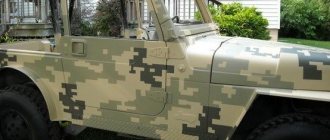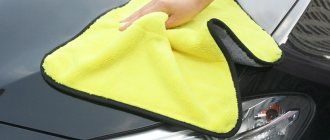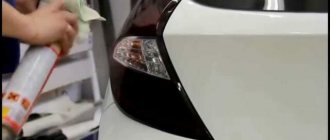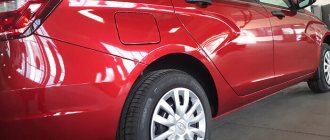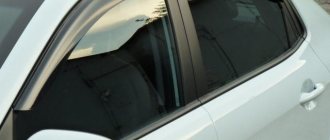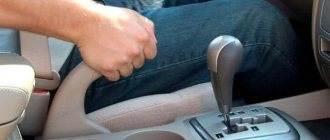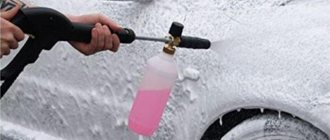Covering a car with film is gaining popularity. Whether it is necessary to glue the film to the car is an individual decision for each owner. Everyone has their own vision on this issue and the pursuit of certain goals. If you have the desire and patience, it is possible to wrap your car yourself. To do this, you need to resort to studying some technological features.
Advantages and disadvantages
Body coating is acquiring more and more positive aspects than disadvantages.
Advantages:
- In addition to scratches and chips, dents are hidden. After pasting, the unevenness will be visible from a certain angle.
- The coating protects against weather conditions (sunlight, rain, hail), mechanical defects.
- When using transparent film, covering can be done on headlights and mirrors, which will keep them in their original condition for many years.
- If properly maintained, it can be used for up to 7 years without restoration.
- Changing the style according to the wishes and capabilities of the car owner.
- Affordability.
- Large assortment of colors and shades.
Disadvantages appear when working with cheap materials and poor quality preparation:
- Deformation of the coating.
- Burnout, possibility of peeling off when exposed to direct sunlight.
- Surface roughness.
Another point is that if the color of the material and the color of the car do not match, you will have to redo the documents for the car and introduce a new tone.
Interior finishing options for Lada cars
Options for tuning the interior with film can be seen in the photo (the work was done using Photoshop specifically for Lada.Online). For comparison, we post three images of modern cars: Lada Priora, Granta, Kalina, Vesta, XRAY, Largus and Niva 4x4:
- Staff salon;
- Wood effect film;
- Carbon film.
Types and features of films
There are two types: vinyl, polyurethane. The protective properties of vinyl are due to their thickness, and that of polyurethane due to their abilities.
When purchasing vinyl material, pay attention to:
- adhesive composition on the surface of the back side of the vinyl;
- thickness in microns;
- width;
- strength, elasticity;
- possible service life.
The range of vinyl by type falls into several categories:
- Matte. The advantage is the adoption of fairly complex shapes. Service life up to 7 years.
- Glossy. Mainly used for reupholstering body parts.
- Mirrored. Prevents the formation of body rust. Available in two colors - gold, silver. Service life depends on the manufacturer.
- Carbon. Availability at different prices depends on the quality. Service life from 5 years.
- Textured. Used to imitate various materials: wood, metal. The material is dense, service life exceeds 10 years.
There are several other options for vinyl film (chameleon, etc.), but they are expensive and very rarely used.
Durable polyurethane (up to 300 microns), protects the body from scratches and impacts. Capable of transmitting ultraviolet radiation, which is important when wrapping not the entire car (when the material is removed from a part of the body after a few years, the color of the entire car will be uniform). The price is more expensive than vinyl.
Paintwork damage repair
Vinyl material not only does not hide defects in the car body, but can also make them more noticeable (especially if it is a matte finish or carbon film). When choosing auto vinyl over painting a car, you must understand that the preparation must be no less thorough.
Particular attention should be paid to areas of corrosion, since the corrosion process will continue under the film, which will very quickly lead to peeling or swelling of the car vinyl.
If the car body is in satisfactory condition, it is often enough to hide large chips and deep scratches. If the damage is not too severe, you can do without puttying and priming. Otherwise you need:
- degrease the damaged area, clean with P120 abrasive. Corrosion areas must be treated with a rust converter and then primed with epoxy primer;
- fill the defect with universal putty;
- sand the putty first with abrasive P120, and then with finishing abrasive P320;
- prime the putty areas with acrylic primer;
- clean the soil with abrasive P320 at the initial stage and P600-P800 at the finishing stage.
We did not describe each of the processes, since we have already devoted separate articles to filling and priming your car.
What will you need for pasting?
Before wrapping a car, we study what is necessary and what may be needed in the process. To apply film you will need the following materials and tools:
- The film itself. It is advisable to take it with a reserve or choose one with a larger width. The specialist will tell you the number of meters and which company to buy.
- Sharpened scissors, a sharp knife, preferably a stationery knife.
- Spray bottle with soap solution (prepared from water, liquid soap, detergent, car shampoo in a ratio of 10 to 1).
- Paper tape.
- Two types of squeegee (spatula): plastic, felt.
- To degrease the surface, alcohol or solvent is required.
- Technical (professional) hair dryer.
- Lint-free cloth or napkins.
- A special composition for enhancing the properties of the adhesive side of the material - 3M primer (A transparent liquid with a pungent odor enhances the adhesive effect of the self-adhesive material, has no analogues).
You need to prepare all this in advance so that you can quickly take it if necessary.
To cover a car, a film from 80 to 200 microns thick is used.
Air removal, correct twists, carbon
To avoid problems and poor-quality film application, it is recommended to wait until the material cools down after applying it to the surface. Having discovered air under the film, you need to carefully pierce the bubble with the tip of the blade along the surface and run your finger along the pasted material. The flaw will not be noticeable. Bubbles of small diameter resolve on their own after some time.
Proper folding must be done while the vinyl is heating up. With the help of a professional hairdryer, the material is heated, stretched at the point of the fold and placed on the corner. The film must be stretched so that it covers the corners well. After completing the work, you should warm up the surface, wait until it cools down and only then cut off the excess material.
Methods of wrapping cars with film
There are two ways to glue vinyl film to a car: wet and dry. These methods are similar in the application process, the difference is the application technology.
Wet method
The wet method is more convenient if you are applying it for the first time or with your own hands. Either the adhesive layer or the surface itself is moistened with the solution. This will allow, if necessary, to correctly direct the material when it is displaced on the body. All soap solution and bubbles are removed using a squeegee and hair dryer.
Dry method
This application method is chosen by specialists who are confident in their work. It is much faster than the previous one. The material is glued directly to the surface of the body with great precision. With this method of gluing, the vinyl does not need to be dried, which increases the service life of the coating.
How to prepare the body
In order for the adhesive coating to adhere well and last for a long time, the car body must be carefully prepared before applying the adhesive. Preparation stages:
- Washing the body with car shampoo, drying or wiping it.
- Carefully inspect the surface to identify damage and difficult-to-clean contaminants. If there are traces of tree buds, bitumen or glue or similar stains on the body parts, remove them with alcohol or a special product. Do not use aggressive solvents that can damage paint and varnish. If there are large chips, scratches and dents, repair them. Otherwise, the sticker will not fit well, and corrosion may form underneath it.
- It is advisable to polish the body if the car is not new. After polishing, the material will adhere better and last longer. And it will be much easier to remove it.
Do not apply stickers to items with areas of rust, peeling paint, large chips or scratches to the primer or metal. To avoid more severe damage to the paintwork and corrosion, it is better to repair defects on your own or at a car service center. Sometimes it is allowed to stick film materials onto unpainted, primed surfaces.
Instructions for gluing
By following all the rules, you can quickly and efficiently cover your car with auto vinyl.
General principles and rules
If vinyl is chosen for covering, it is better to cover the body completely rather than partially. This is due to the fact that it does not allow sunlight to pass through, and the color of the car will not completely fade. This will be very noticeable after removing the film.
Before the coating itself, it is necessary to carefully prepare the surface of the car. If there is rust somewhere, this place needs to be treated and puttied to prevent the spread of metal corrosion.
Conditions for pasting
Initially, you need to choose the place where the work will take place. This could be a garage with good lighting; the room temperature should be at least 20 degrees.
Cleanliness is the key to quality coating. The smallest speck of dust or particle caught under the film coating will ruin the entire appearance. The work will have to start again. Therefore, before starting work, wet the floor surface to prevent dust from flying.
Such work cannot be carried out on the street!
Preparing a car for wrapping
Before sizing a car, it must be carefully prepared. The preparation stages include:
- If the surface contains some suspicious places (where the paintwork may come off), it is better to clean it immediately, since the film may be adjusted several times during the work.
- For convenient gluing in hard-to-reach places, it is better to disassemble the body in as much detail as possible.
- Wash and dry the surface very well.
- Treat the surface with a degreaser solution.
- When gluing, apply a primer in bend areas for better adhesion to the surface.
Pasting process
After preparing the car, you need to move on to preparing the material for wrapping. Make patterns in accordance with the places where the gluing will take place:
- apply vinyl around the perimeter to the surface;
- secure with paper tape;
- make appropriate marks, taking into account the reserve;
- cut out.
When pasting wet on a prepared surface:
- a soap solution is applied;
- the protective layer is removed from the film;
- The material is glued in the center and then slowly move to the edges, smoothing with a squeegee;
- if bubbles have formed, carefully remove them from the place of formation with a squeegee along with a soap solution and the bubbles will disappear;
- in the bend areas, heat the material with a hairdryer, and apply a primer to the edges, from the side of the adhesive base;
- if irregularities appear on the bend, heat it up a little more;
- After applying the film, the entire surface is heated for better adhesion and getting rid of some imperfections.
When pasting using the dry method, the application process is repeated, the difference is that the material is applied to a dry surface of the body. After application, the carbon coating is heated. Pass over the surface with a felt squeegee and wipe with a dry cloth or rag.
Heating should not exceed 70 degrees to avoid color loss and destruction!
When applying, carefully ensure that the material does not stretch too much and bubbles do not form. If this happens, it is recommended to press the unfinished area with a wet rag and treat it with a hot stream of air. The vinyl should shrink a little, the imperfections will be hidden.
After application, it is not recommended to wash the car or drive at high speed for 10 days. This time is necessary to dry the material.
We recommend watching this video before starting work:
How to choose a film
Now there are many films of various colors and with all kinds of decorative effects. Materials can imitate carbon, be matte or mirror, have different designs and patterns, 3D or 4D images. You can order stickers with an individual design. Sometimes this is necessary for car branding, for example, for working in a taxi or any company.
Most car wrap films are made from vinyl. Good quality products are easy to apply and easy to remove. They have a long service life of at least five years. These are materials from the brands 3M, Arlon, Hexis, KPMF, Oracal and other American and European manufacturers. Their disadvantages are the relatively high cost and a large number of fakes. Therefore, you need to buy products from places with a good reputation.
Many adhesive materials from China and South Korea are short-lived and of low quality. They can successfully serve for a couple of years, or even less. Such stickers are difficult to remove from the surface and may leave marks and damage to the paintwork. Sometimes they do not stretch well when glued, tear and quickly begin to peel off. Chinese products can develop noticeable defects even with minor mechanical or chemical exposure, for example, after a regular delicate body wash. Their only advantage is their low price. But those who value the condition of their car and want it to have a beautiful appearance should not skimp on film and take the cheapest varieties. And what design to choose is a personal matter for everyone. But you should not buy materials with a strong mirror effect or imitating the colors of special vehicles. This is prohibited by traffic rules and unsafe.
Pasting process
If you want to properly wrap your vehicle with vinyl film, you need to follow the following algorithm:
Wash and dry the vehicle thoroughly. This needs to be done even if you are going to paste over only individual parts of the body. Treat all surfaces on which you are going to glue vinyl using white spirit degreaser (or any other). You must make sure that there are no traces of dirt, dust, rust or sand left on the surface.
Car vinyl wrapping- Do a fitting. To do this, you need to attach the film to the place where, according to your plans, it should be pasted. In this case, under no circumstances should you tear off the backing or mounting layer! After you choose the most suitable location for the coating, it is advisable to mark the places where the edges will be located using masking tape. Fitting is a very important stage, and therefore it should not be done “in a hurry.”
- Cut a piece of vinyl flooring to the size you require. In this case, it is better to leave a small amount of space on all sides.
- Place the film on a horizontal surface, then peel off the white paper that serves as the backing. At the same time, this must be done while constantly monitoring to ensure that the film does not stick to itself. It is best to tear off the backing at an angle of 30-40 degrees.
- Apply a soap solution to the car part to be pasted - it is better not to spare it and cover the entire surface with an even thick layer. This will ensure that bubbles are eliminated and that the film can be moved after application.
- Apply the coating to the surface of the car. At the same time, it must be slightly pulled at all times and fixed at the extreme upper corners. From the middle to the edges, the coating must be rolled using a rubber squeegee and simultaneously dried with a hair dryer. You need to roll from the middle to ensure that all remaining soap solution and air bubbles are removed in time. If you notice that the formation of a fold is inevitable in some area, you can lift the coating and stick it again, heating it in parallel with a hairdryer.
- To fully activate the adhesive, you need to re-use a hairdryer over the entire surface of the coating after it has already been glued. At the same time, you need to roll it out with a felt squeegee.
Car wrapping with vinyl film
- Trim the edges of the coating with a margin of 5 millimeters and glue to the surface with ordinary glue with sealing properties. Due to the fact that vinyl peeling always starts from the edges, this step must be carried out with special care.
- Go over the entire surface of the vinyl with a rag. After this, the car should be left for about a day at the same temperature. After 24 hours, the vinyl will completely adhere to the surface. For 7-10 days after you have covered your car with vinyl film yourself, you cannot wash the car yourself. Also, of course, you should avoid visiting automatic car washes.
Calculating benefits
One order usually takes from two to three days of work. But in the cold season, the technology for gluing vinyl film stretches for another day. Usually two cars are processed at the same time - while one is being prepared for wrapping, cleaned of contaminants, a film is applied to the other. Then the pasted car is placed in a settling tank to secure the film, and work is carried out on the next car.
In a month of work, you can cover up to 15 cars, if no unforeseen situations arise. But not all clients order complete treatment of the machine; in most cases, only certain parts of it are covered. Most often, vinyl film is applied to the hood and doors. On average, you can count ten fully covered cars per month of work.
It takes about 25 square meters to completely cover the machine. meters of film material at a film cost of 1000 rubles per square meter. meter. Sometimes, at the request of the client, some kind of printing on vinyl film is required, this is carried out by a specialized company. If you add up the costs of materials, markups for selling them to clients and wages for employees, then the price of wrapping a car body with vinyl film is about 42 thousand rubles, half of which is the cost of materials. You can earn 21 thousand rubles on one car. For four weeks of work, income can be up to 315 thousand rubles.
If you subtract the rent for the garage, advertising costs and electricity fees from the monthly income figure, which in total will be about 30 thousand rubles, you will get a balance of 285 thousand rubles. In a few weeks, this profit will be clear, and you can think about investing in another profitable enterprise.
Tools, materials
To work you will need:
- a squeegee, with which the film is smoothed and air bubbles are expelled;
- a stationery knife, which will be convenient for trimming the remaining film;
- sprayer, commonly used for gardening and vegetable gardening. We need it to spray soap solution;
- hairdryer At temperatures above +20ºС, in the absence of a powerful hair dryer, even a household hair dryer will do;
- degreaser;
- a primer that enhances the adhesion of the adhesive layer;
- paper napkins. These are used when painting a car to remove dirt and degrease. In order for the coating to serve for a long time, not to swell and not come off the edges, the surface must be perfectly clean. If the car vinyl is not glued to a car that has recently left the walls of a car dealership, then we recommend buying clay for car bodies. It will help remove stubborn tar deposits, clean dirt from micropores and cracks in the car's paintwork. This will improve adhesion and extend the service life of the film;
- dry rags to remove residual moisture.
Carbon-look film or any other texture can be glued using a soap solution (wet method) or dry. Dry wrapping of a car provides more reliable adhesion of the adhesive layer and better adhesion on bends, but is not very suitable for work without experience. A wet surface is more forgiving of mistakes, since the film is easier to move and lift to remove air.
Which films are easier to glue?
If you have no experience working with car vinyl, which is quite likely if you are reading this article, we do not recommend choosing the cheapest films for your car. Due to their poor quality, they are difficult to paste, as they have poor elasticity and are often subject to shrinkage and swelling. Understanding of many things will come to you only directly when pasting with your own hands. Therefore, in order not to spoil the expensive material, we highly recommend buying a small piece of the cheapest training film. You can cover, for example, the plastic in the interior with carbon fiber, and only then move on to pasting complex car parts and large areas.
For beginners, we recommend choosing a material with channels on the inner layer. It is much easier to remove air bubbles from under such vinyl. Also, you should not practice on carbon-look films, unless you are gluing it to an inconspicuous small interior part. The rectangular structure of the image does not allow stretching of the material, stylized as carbon, as distortions are immediately visually noticeable. In this regard, ordinary car vinyl is much more forgiving of mistakes, and therefore the first experience of car wrapping has a greater chance of success.
Preparing the machine surface before installation
Most models of windshields are produced together with an adhesive base designed to fix this device. Otherwise, you need to purchase specialized tape, which is preheated with a hair dryer.
In addition to a hair dryer, you will need a dry rag and a technical solvent to fix the plastic pads. After preparing the specified components, you will need to perform the following steps:
Wash the car body and windows, paying special attention to those areas where you need to stick plastic covers. Treat the body and windshields with a technical solvent, removing the fat layer. Carry out additional treatment of the body coated with wax polish or paraffin mastic.
If the car has old deflectors, then to dismantle the deteriorated linings you will need:
Open and lock the side door. Using a heat gun, warm up the junction of the deflector and the car body
This procedure must be carried out with extreme caution. Overheating will cause the paintwork to peel off from the surface of the body. Pry up one of the ends of the old lining and insert the fishing line. Run the fishing line along the entire deflector, thus detaching the trim from the body
During this procedure, you should also be careful to avoid contact with the surface of the body. After dismantling the old windshield, treat the surface with a solvent.
If the old windshield is plug-in, then dismantling is carried out in two stages. First you need to pry one edge of the deflector, and then pull the plate towards you. At the end of this procedure, it is also necessary to clean the surface of the body.
New deflectors can be installed provided that the ambient temperature is above +10 degrees. The procedure is prohibited in winter. In the cold, the adhesive composition does not set, which is why the deflectors will fall off a few hours after installation.
Necessary work before the procedure
Like any work related to a car, gluing the hood with film requires additional preparation. If you do not perform the correct set of actions, the life of the film will not be long-term or the film will not initially lay down smoothly, without the formation of bubbles.
Work order:
- Before covering with film, the car must be washed thoroughly so that no pieces of dirt remain on the hood, which can cause air bubbles to form on the surface of the film. It is advisable to take your car to a professional wash for a good result.
- The surface of the hood should be thoroughly degreased using special means that will not damage the paintwork of the car. Such degreasers are indicated in the instructions for using car film.
- And the final stage before pasting includes puttying and painting problem areas, as well as thoroughly drying the surface (the film is applied only to a clean, dry surface).
Work should be carried out in a dry, warm room for better adhesion of the film to the hood parts.
About the choice of material
In short, you need to choose 3D carbon. The reasons are obvious:
- 2D films are not durable, and they are not at all similar to real carbon fiber;
- 4D, firstly, is very expensive, and secondly, finding it on sale is not so easy. Even today in many cities of our country it is very exotic;
- Another argument in favor of choosing 3D is the ability of its PVC base to greatly stretch when exposed to sunlight. Many cheap 2D ones (especially from Chinese manufacturers) do not have this ability, since their PVC base is very thin. Because of it, they quickly crack, especially if the car is used in sunny regions of the country;
- finally, almost all 3D films in the adhesive base have special channels for air removal, which cannot be said about 2D carbon. Thanks to these channels, the 3D is easily smoothed out and there are almost no air bubbles left underneath. But a driver who has chosen 2D carbon often has to resort to various tricks to eliminate the air bubbles remaining after smoothing (for example, they are removed by piercing the 2D with a thin hot needle).
Results
Film development is at the highest level. So there is nothing to be afraid of. Rather, you should be glad that you can stick to it, try yourself in a new area and, if necessary, remove the film without leaving a trace. In 5 years of experience, I have never seen or heard anything. What kind of shitty film did you have to hold in your hands? But this is an invaluable experience that we pass on to you free of charge. My verdict is this: An old car with chips, you want to seal the car for half a year or a year - the best choice would be Oracle 641 or Hexis Ecotak. A new car and planning to drive for at least a couple of years - Arlon S5000 polymer is the best price/quality option, but only one color available in Russia. Well, or orcal 551, there is more than a range of yellow colors. PS As for the white film for the entire body, there are still the same recommendations, but regarding the choice of film for pasting stripes in accordance with GOST of the Moscow region, this is a completely different story...
